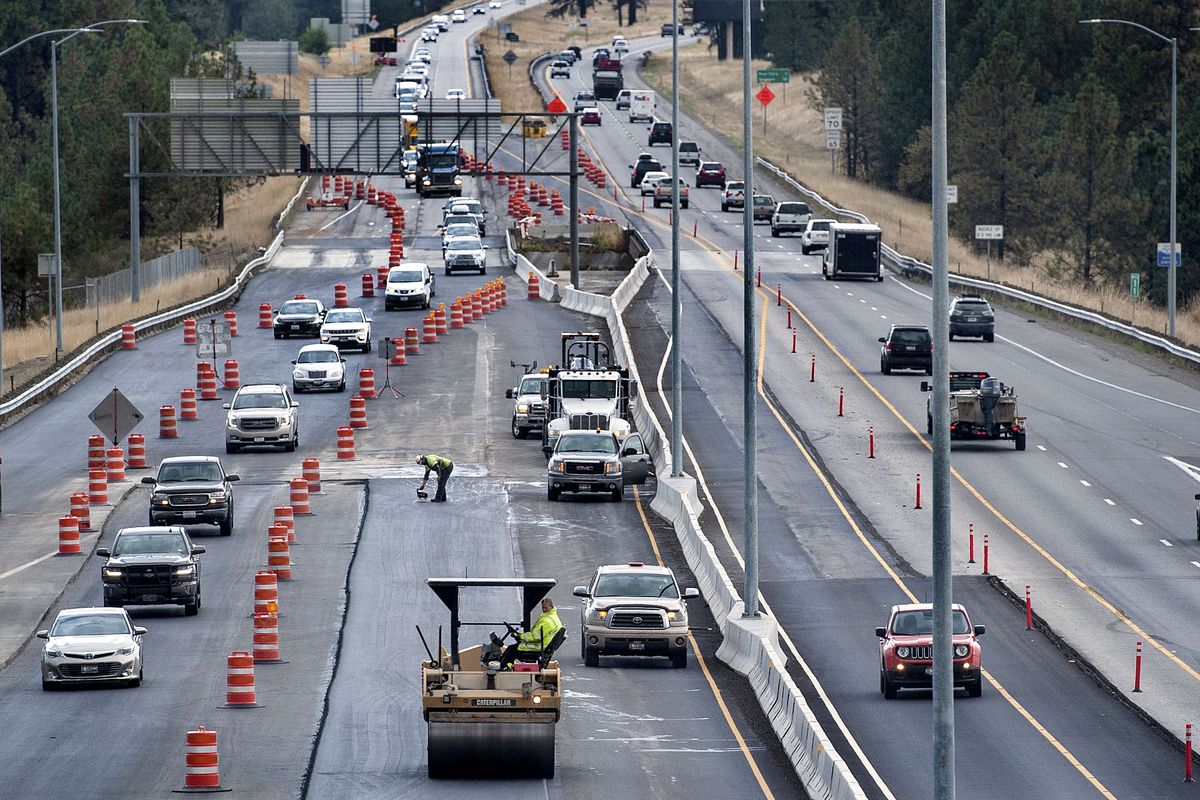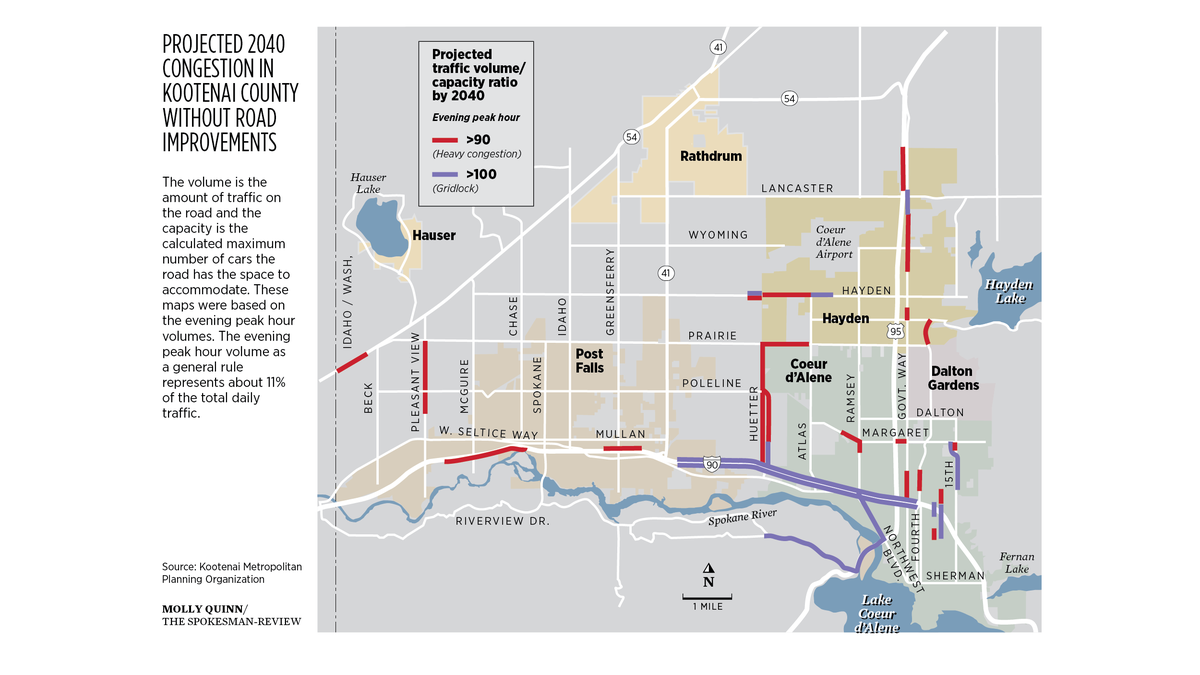This column reflects the opinion of the writer. Learn about the differences between a news story and an opinion column.
Getting There: Can a 6-lane I-90 and $1.5 billion prevent gridlock in 300,000-person Kootenai County?
Construction on I-90 through Coeur d’Alene is seen in this September 2018 photo. Planners are making the argument that the interstate should be widened to six lanes in order to alleviate future traffic headaches as Kootenai County’s population continues to boom. (kathy plonka)
It’s safe to say people aren’t moving in droves to North Idaho because they want to sit in gridlocked traffic.
But that’s already starting to happen and will become a daily occurrence if nothing is done to expand the county’s highways and roads, according to Glenn Miles, executive director of the Kootenai Metropolitan Planning Organization.
In a presentation to the Coeur d’Alene City Council earlier this month, Miles showed what he called an “artery chart” of congestion on area roads both now and in the near future.
Those charts depict the ratio of traffic volume to capacity.
“If you see yellow,” he explained, “that’s not too bad. If you see red, we have a problem. And I call it my ‘artery chart’ because if you see purple, you’ve lost your oxygen and you’re not going anywhere.”
On a map of today’s travel demand, the purple is isolated to a handful of intersections, and the red is mostly contained to a long strip of Interstate 90 between Coeur d’Alene and Post Falls.
While Miles said the map shows “we’re not in too bad of shape right now,” he also noted that evening eastbound interstate traffic is slow.
“And if there’s any type of incident that occurs during that time, it stops,” Miles said.
Getting the traffic flow going again, he said, can take between 35 and 50 minutes.
Flash forward to 2040, though, and Miles’ artery chart shows a patient on life support.
“We’re going to be in a world of hurt,” Miles told council members. “You see I-90 basically at gridlock in both directions between U.S. 95 and Highway 41. You see stop-and-go traffic constantly on both U.S. 95 and Government Way. And then you see some challenges further north as well. And one that I think is particularly concerning as well is the U.S. 95 bridge over the Spokane River, which is a key artery for commerce going north-south in Idaho.”
The cause of all the projected congestion, of course, is all the new people projected to flood into the county, plus the lack of infrastructure investments to keep up with the demand they place on the transportation system.
The last time major investments were made in Kootenai County in the late 1960s and early ’70s, it was a rural county home to about 35,000 people.
As of last year, the population had swelled to just more than 170,000.
Over the next 20 years, another 130,000 people are expected to pack in, creating a sprawling metropolitan area of 304,000 residents, according to the KMPO.
And the wheels are at last in motion to begin work on some major projects designed to accommodate all those new people and all their new cars.
The Idaho Transportation Board has funded environmental studies for widening I-90 to six lanes from the state line to Sherman Avenue and for building the long-planned Huetter Bypass, a highway-style connection from I-90 to U.S. 95 along what is now Huetter Road.
Miles told council members he expects work to begin within the next couple of months on both of those studies, which are prerequisites for shovels hitting dirt.
While it may take 18 to 24 months for those studies to be complete and work to begin, Miles is confident that day will come and believes work on the interstate widening could begin soon.
Between 2023 and 2026, he told councilmembers, “you can expect I-90 widening,” as well as a new I-90/U.S. 95 interchange. During the same period, he said, work is expected to begin on a new interchange at State Highway 41, which is currently being rebuilt as a four-lane divided highway.
But that’s not the only work he wants to see.
He’s also advocating for the creation of a regional traffic management center, the replacement and widening of the U.S. 95 bridge over the Spokane River and moving the port of entry to improve the flow of truck traffic.
Though he emphasized he was “ballparking,” Miles said the cost of those “big five” projects will approach $790 million, including about $425 million for widening I-90 and $300 million for the Huetter Bypass.
Money from those projects will have to be allocated by the Idaho Transportation Board, but the state should have a much bigger pot to pull from for transportation projects after the Legislature increased the share of gas tax revenue that goes to such work.
Miles said that change is expected to generate about $84 million next year, up from about $20 million. That money could then be bonded to the tune of about $1.4 billion.
But even if those “big five” projects are funded and built, Miles said Kootenai County will remain a long way from meeting its transportation needs.
After consulting with local jurisdictions and highway districts, KMPO has identified some $682 million in local improvements that will be required to meet the county’s needs.
“I’m not going to paint a pretty picture,” Miles told council members. “We are behind the curve by about 20 years, and it’s going to take us more than 20 years to get us out of the curve.”
It will also take an expected a total of $1.5 billion.
And even that, Miles acknowledged in an interview last week, won’t be enough to solve every problem.
“There will still be congestion,” he said, “but there will not be gridlock.”
Even that prediction, though, may not prove accurate, because if a six-lane I-90 does ease traffic flow through Kootenai County, what happens when westbound traffic arrives at what’s now a four-lane interstate at the Washington state line?
The answer, more than likely, is more gridlock.
Asked whether the Washington State Department of Transportation has plans to widen the interstate between the border and Barker Road, spokesman Ryan Overton said it’s something the department has studied but is “not currently pursuing funding for.”
Work to watch for
Monday through Thursday, crews will be working on utility adjustments at Southeast Boulevard between Perry Street and 29th Avenue as part of a chip-seal project.
Freya Street between 37th Avenue and Palouse Highway will have single lane closures with flaggers on-site on Tuesday for another chip-seal project.
Freya Street between Wellesley Avenue and Upriver Drive will have single lane closures with flaggers on-site on Tuesday for the same reason.
Chip-seal work will also close Nevada Street completely between Wellesley Avenue and North Foothills Drive on Wednesday.
Work on the Barker Road/BNSF Grade Separation Project in Spokane Valley has led WSDOT to temporarily reduce the speed limit from 50 mph to 40 mph on westbound Trent Avenue between milepost 12.30 to milepost 13.03.


